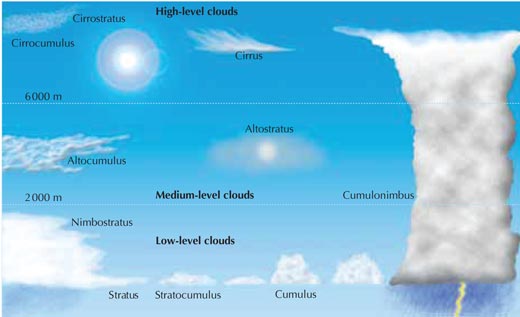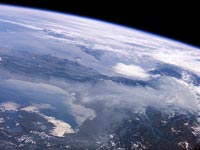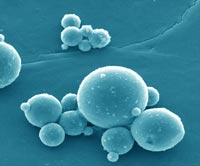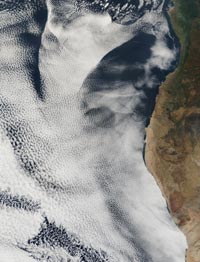Clouds: puzzling pieces of climate Understand article
The physics of clouds and their role in our climate have perplexed scientists for decades. Karin Ranero Celius investigates.

Do clouds affect our climate, or does the climate have an effect on clouds? Both are true. However, clouds are so difficult to understand that they are not yet well incorporated into climate models. That would require us to understand how clouds form, why they appear and disappear, and why and when they precipitate. To this end, scientists must analyse the behaviour of individual clouds, their components and their effect on the surroundings.
Essentially, clouds are visible masses of water droplets (or even crystals), suspended in Earth’s atmosphere. To study them, researchers divide them into categories. Thin and wispy clouds are called cirrus clouds. Cotton-puffs, or heaps of cotton-puffs, are cumulus clouds. On a cloudy day, the sky is usually covered by flat, hazy and featureless stratus clouds. Each cloud can be classified as one or a combination of these types of clouds (see diagram below).

Image adapted from Russell et al. (2007); courtesy of the Institute of Physics

fine particles in the grey mist
can delay the rain
Image courtesy of NASA
Furthermore, clouds are classified according to their altitude into: low-level (up to 2000 m), medium-level (2000-6000 m), and high-level clouds (over 6000 m). The height of the clouds determines their temperature, which then determines how much energy they radiate. High-level clouds are cold and radiate little heat into space; instead, they reflect heat radiation back towards Earth’s surface, warming the atmosphere and magnifying the greenhouse effect. Low-level clouds, more compact and warmer, emit more heat radiation into space than back towards Earth. They act as a parasol, reflecting sunlight and thus cooling Earth’s surface.
A cloud’s altitude, therefore, determines its effect on the climate. By studying the occurrence of high-level and low-level clouds, we can begin to understand the roles they play. If both types of clouds were to occur equally, then the warming and cooling effects would counteract each other, resulting in little heating or cooling of Earth’s surface. If the occurrence of high-level clouds increased while that of low-level clouds decreased, there would be a notable increase in atmospheric temperature.
So, why do clouds appear and disappear, and what determines their formation and precipitation?
Cloud seeds

under a scanning electron
microscope
Image courtesy of the Max
Planck Institute for Chemistry,
Mainz, Germany
All clouds have one thing in common: they form from cloud seeds – also known as aerosols. When water evaporates under the Sun’s heat, the vapour rises into the air and the water molecules condense on the aerosols – which can be natural, such as salt, or anthropogenic, such as sulphates. If the cloud seed is at least 60-80 nm in diameter, a water envelope can collect around it, forming a droplet. The cloud consists of many of these droplets. If the droplets reach a diameter of 0.5-1 mm, they will fall – colliding with other droplets, assimilating them and swelling into raindrops, which can fall at up to 35 km/h.

Image courtesy of Stephan Borrmann
Aerosols play an important part not only in cloud formation, but also in precipitation: they determine when and where it rains. In a pristine atmosphere with very few particles, sunlight evaporates a great deal of water. As it rises, the vapour finds very few condensation seeds in the air, so the drops forming around those few seeds are very large, and it rains heavily.

Image courtesy of Roland Wengenmayr
In a polluted atmosphere, the large number of aerosol particles prevents much of the Sun’s radiation from reaching the ground, causing less water to evaporate. As the vapour rises, it finds many seeds, creating more, but smaller droplets. This slows down the formation of raindrops (droplets only fall once they reach 0.5-1 mm), so it does not rain on the point of origin. More water condenses on the seeds as the cloud continues to rise and the low temperatures freeze the drops. So the cloud does not rain, but continues to climb higher.

Image courtesy of Roland Wengenmayr
High concentrations of aerosols can inhibit precipitation and even cloud formation entirely. The aerosol concentration in northern China, for example, is thought to be the cause of the major shift in the frequency of precipitation. On a global scale, of course, all water that evaporates must eventually precipitate. Thus clouds that only rarely empty their contents will do so in the form of heavy rainfall, causing floods, landslides and mudslides.
Puzzling hurly-burly
Although aerosols explain the formation of clouds, and to some extent the occurrence of precipitation, they do not explain another crucial factor in climate: why do clouds change shape, and why do they appear and disappear?

these off the coast of
southwest Africa reflect the
sunlight. Will their number
increase as the climate
changes?
Image courtesy of Jacques
Descloitres, MODIS Land Rapid
Response Team, NASA / GSFC
The shape and lifespan of clouds, and thus their influence on climate, is determined by turbulence. At the edges of a cloud, turbulence mixes the dry surrounding air with the moist cloud air. This is called ‘mixing entrainment’. On a microscopic scale, entrainment changes the distribution and size of the cloud droplets, affecting the cloud’s tendency to rain or dissipating the cloud completely. But its effect can also be global. For example, if clouds over the frequently cloud-covered southeast Pacific Ocean disperse, there will be more solar radiation, contributing to phenomena like El Niño, which is characterised by an increase in the ocean’s temperature.
To forecast the fate of a cloud, scientists must know how turbulent the droplets are: this determines how fast the raindrops form and fall. However, studying turbulence in clouds is a complex task due to the different dimensions of clouds’ components (a tiny droplet, a larger raindrop, an air current) and the physical processes taking place within and between them.
To understand the effect of turbulence, not only the droplets’ velocity and trajectory but also their acceleration is important. Acceleration fluctuates considerably, and can peak at more than 20 times gravity. The frequency of collisions, which increase the chances of precipitation, is determined by particularly strongly accelerated groups of droplets. These strong fluctuations in acceleration could explain why droplets are found to collide more quickly than conventional physics theories allow.
Closing in on clouds
While some scientists try to recreate the conditions of turbulence in clouds using huge wind canals, others study it using computer simulations and fieldwork.

factors influence the
structure of tropical rain
clouds
Image courtesy of David
Ausserhofer
For example, Björn Stevens, a researcher at the Max Planck Institute for Meteorologyw1 in Hamburg, Germany, studies marine stratocumulus clouds, which form over cold regions of the subtropics, such as off the Californian and South American Pacific coasts and over the Atlantic coastline near Namibia. They exert a great influence on the global climate, covering more than one tenth of the oceans’ area. Stevens found out that these clouds are quite peculiar: satellite images show ‘holes’ in the solid cloud blanket and although the clouds do not normally cause heavy rain, they do so around the holes. And when these clouds rain, turbulence – the circulation of air between the ocean and the cloud – can change radically.
Stevens and his colleagues are now incorporating their newly gained information on cloud behaviour into the global climate computer models. In these models, the atmosphere is divided into grid boxes; for each box, the computer calculates average values of temperature, humidity and other characteristics of the atmosphere, and predicts cloud formation. Although the models are not yet precise enough to predict the exact locations where the clouds will form, they can now calculate the degree of cloud cover and type of clouds in each grid box, thus allowing the influence on heat and solar radiation on cloud formation to be quantified.
Scientists, therefore, are still investigating the relationship between cloud cover, precipitation, aerosols and the properties of air surrounding clouds – all fundamental for understanding the link between clouds and climate change. So far, they are not even close to deciphering all the different mechanisms involved in the behaviour of clouds and thus, their effect on our climate. But the scientists will not give up, because, as the French Renaissance philosopher and naturalist René Descartes said: “Clouds provide the key to understanding all things wonderful on Earth.”
Acknowledgement
This article was compiled from three articles published in Max Planck Research: Meier (2010), Hergersberg (2010) and Wengenmayr (2010). Max Planck Research is published by the Max Planck Society and describes – in simple language – the work of its research institutes. The quarterly publication is freely available to downloadw2.
References
- Meier C (2010) Water with a Nebulous Effect. Max Planck Research 2.2010: 17-23
- Hergersberg P (2010) Droplets on a Roller Coaster. Max Planck Research 2.2010: 32-37
- Russell A, Ricketts H, Knight S (2007) Clouds. Physics Education 42(5): 457-465. doi: 10.1088/0031-9120/42/5/002
- Wengenmayr R (2010) The Seeds of Climate. Max Planck Research 2.2010: 24-31
Web References
- w1 – Learn more about the Max Planck Institute for Meteorology by visiting their website.
- w2 – Download each issue of Max Planck Research (available in English and German) by visiting the website of the Max Planck Society.
Resources
- To learn more about climate change and its causes, see:
- Benestad R (2007) What do we know about climate? The evidence for climate change. Science in School 7.
- Benestad R (2008) What do we know about climate? Investigating the effects of anthropogenic global warming. Science in School 8.
- For activities related to clouds see:
- Bultitude K (2009) Take the weather with you. Science in School 11.
- For activities for the classroom about climate change see:
- Shallcross D et al. (2009) Fuelling interest: climate change experiments. Science in School 11.
- Shallcross D, et al. (2009) Looking to the heavens: climate change experiments. Science in School 12.
- Shallcross D, Harrison T (2008) Climate change modelling in the classroom. Science in School 9.
- Shallcross D, Harrison T (2008) Practical demonstrations to augment climate change lessons. Science in School 10.
- In this issue, there are two further related articles:
- Harrison T, Shallcross D (2010) A hole in the sky. Science in School 17.
- Schülli T (2010) Science is cool… supercool. Science in School 17.
Review
At a time when many countries worldwide are working together to increase the use of renewable resources and reduce climate change and its effects as much as possible, this article brings a new perspective. The author provides detailed and interesting information about the relationship between clouds and climate change, giving examples from various parts of Earth.
The article can be used for several science subjects, such as:
- General science: formation of clouds and precipitation (ages 10-12). The article would have to be simplified by the teacher and probably some details such as fluctuations in acceleration would have to be omitted to keep it simple enough for young students.
- Geography: weather observations, types of clouds, altitude of clouds (ages 10-16+)
- Physics: reflection and radiation of heat, greenhouse effect, climate change (ages 13+)
The article can also serve as an introduction to further activities. Younger students could be involved in observations of clouds, temperature, humidity and the amount of precipitation, after which they could present their results in class. They could also discuss the effect of clouds on climate change and the effect of a polluted atmosphere on precipitation.
The author mentions some specific examples of how clouds affected temperatures and climate in northern China and the southeast Pacific, as well as some current research in this research field. Older students should be motivated to do further research about the relationship between cloud formation and cloud types with climate change.
The large amount of detail also makes this article suitable for comprehension exercises in class. Some suggestions for questions could be:
- What are clouds made of?
- How are they formed?
- How do cloud altitude and cloud seeds impinge on the temperature of Earth’s surface?
- What consequences does this have on climate change?
Catherine Cutajar, Malta





